So, you’re finally taking the plunge and setting up your first saltwater aquarium! It’s an exciting time, filled with the promise of vibrant colors, fascinating behaviors, and a slice of the underwater world right in your living room. But before you rush out and buy the first fish that catches your eye, it’s crucial to choose wisely, especially if you’re a beginner.
Reef tanks are delicate ecosystems, and some fish are more compatible than others. To ensure a harmonious and thriving underwater community, you’ll want to start with peaceful, hardy species that are easy to care for. Luckily, there’s a wide variety of stunning and docile fish that fit the bill perfectly.
This comprehensive guide will introduce you to ten of the best peaceful reef fish for beginners, complete with detailed reviews, pros and cons, and answers to frequently asked questions. Let’s dive in!
-
Ocellaris Clownfish (Amphiprion ocellaris)
Review: No beginner reef tank list would be complete without the iconic Ocellaris Clownfish, also known as the Percula Clownfish. These charming fish are instantly recognizable with their vibrant orange bodies, three white bands outlined in black, and endearing personalities. They are active swimmers, but stay relatively small, usually reaching around 3 inches in length. Ocellaris Clownfish are hardy, disease-resistant, and readily available, making them an excellent choice for beginners.
Pros:
- Hardy and adaptable: They can tolerate a range of water parameters, making them forgiving for new aquarists still learning the ropes.
- Personality plus: Clownfish are known for their curious and playful nature, often interacting with their environment and their tank mates.
- Symbiotic relationship with anemones: Though not essential, providing a host anemone creates a fascinating natural dynamic in your tank.
Cons:
- Can be territorial: While generally peaceful, they can become aggressive towards other clownfish or similar-looking species, especially in smaller tanks.
- Prone to “hosting” corals: In the absence of an anemone, they may try to host corals, potentially damaging them.
-
Royal Gramma Basslet (Gramma loreto)
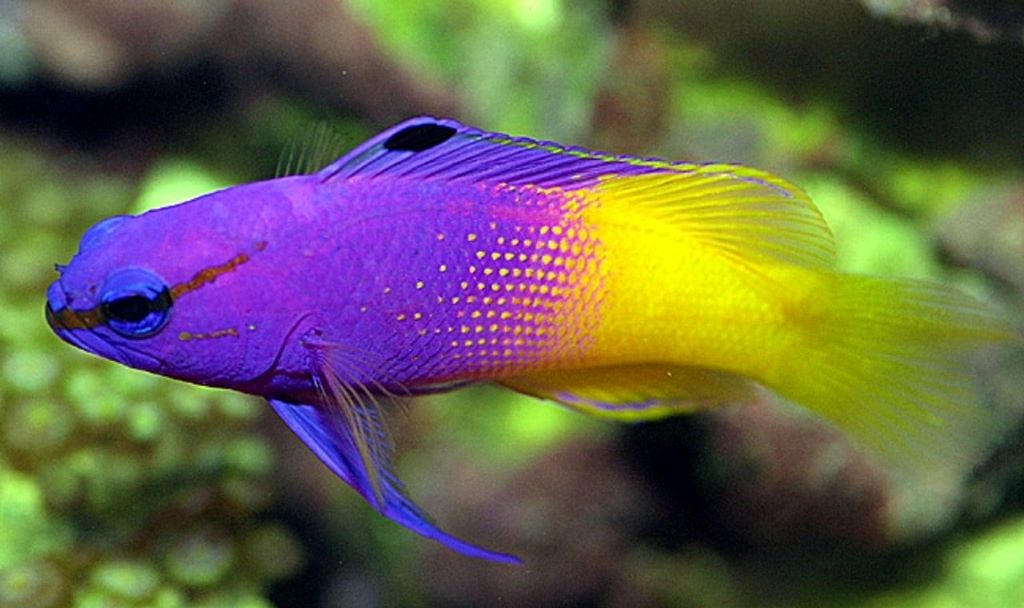
Review: The Royal Gramma Basslet is a jewel of the reef, boasting a striking purple and yellow coloration that adds a pop of royalty to any aquarium. These small fish (reaching about 3 inches) are relatively shy but add a constant splash of color as they dart in and out of rockwork. They are peaceful and reef-safe, making them ideal for community tanks.
Pros:
- Vibrant coloration: Their unique purple and yellow markings make them a visually stunning addition to any reef tank.
- Reef-safe: They won’t bother corals or invertebrates, making them excellent community citizens.
- Easy to care for: They are not picky eaters and adapt well to a variety of tank conditions.
Cons:
- Can be territorial towards other Gramma Basslets: It’s best to keep only one per tank unless you have a very large aquarium with ample space and hiding places.
- Sensitive to poor water quality: Maintaining good water parameters is crucial for their health and well-being.
-
Firefish Goby (Nemateleotris magnifica)
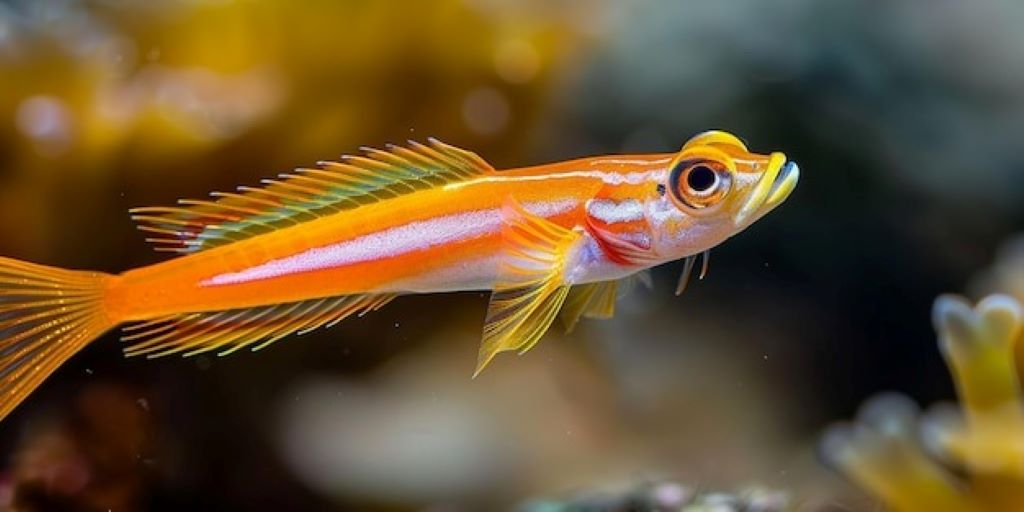
Review: With its fiery red body, elegant dorsal fin, and darting movements, the Firefish Goby is a captivating addition to any reef tank. These shy but beautiful fish hover near their burrows, adding a sense of movement and life to the aquarium. They are peaceful and reef-safe, making them suitable for community setups.
Pros:
- Unique beauty: Their striking coloration and graceful movements make them a mesmerizing sight.
- Peaceful temperament: They are non-aggressive and get along well with other peaceful species.
- Interesting behavior: Their habit of retreating into their burrows when startled adds a dynamic element to the tank.
Cons:
- Jumpers: They are known to jump out of the tank, so a tight-fitting lid is essential.
- Can be sensitive to copper-based medications: Be cautious when treating the tank for diseases.
-
Yellow Watchman Goby (Cryptocentrus cinctus)
Review: The Yellow Watchman Goby is a fascinating fish with a unique symbiotic relationship with pistol shrimps. These hardy fish are known for their distinctive yellow coloration and their habit of “watching” over their burrows, often in partnership with a pistol shrimp. They are peaceful and add a touch of personality to any reef tank.
Pros:
- Engaging behavior: Their partnership with pistol shrimps creates a fascinating natural dynamic in the tank.
- Hardy and adaptable: They can tolerate a range of water conditions and are relatively easy to care for.
- Reef-safe: They pose no threat to corals or invertebrates.
Cons:
- Can be territorial towards other gobies: It’s best to keep only one per tank or provide ample space and hiding places.
- May rearrange the substrate: Their burrowing activities can disrupt the aquascape.
-
Coral Beauty Angelfish (Centropyge bispinosa)
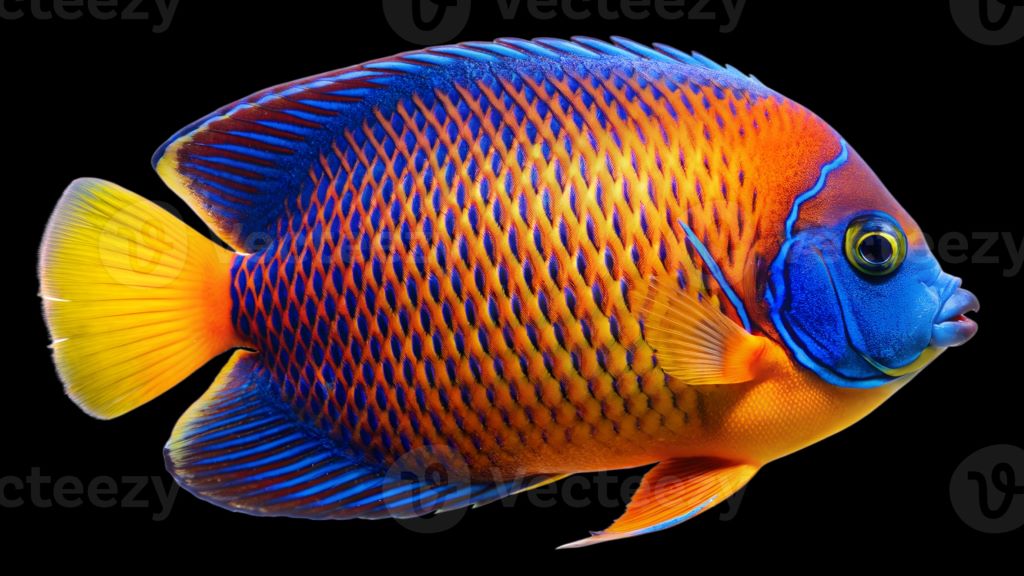
Review: The Coral Beauty Angelfish is a stunning dwarf angelfish that adds a splash of vibrant color to any reef tank. With their deep blue bodies, orange accents, and graceful movements, they are a joy to watch. While angelfish can sometimes be aggressive, the Coral Beauty is generally peaceful and reef-safe, making it a popular choice for beginners.
Pros:
- Beautiful coloration: Their striking blue and orange markings make them a visually appealing addition to any reef tank.
- Relatively peaceful: Compared to other angelfish, they are less aggressive and more suitable for community tanks.
- Grazers: They help control algae growth in the aquarium.
Cons:
- May nip at corals: While generally reef-safe, they may occasionally pick at some coral species, especially if not well-fed.
- Can be susceptible to certain diseases: Maintaining good water quality is crucial for their health.
-
Six Line Wrasse (Pseudocheilinus hexataenia)
Review: The Six Line Wrasse is a small but active fish that adds a burst of energy to any reef tank. Their slender bodies, adorned with six horizontal blue lines, are constantly on the move as they dart around the rocks and corals. They are known for their voracious appetite for small invertebrates, making them excellent for controlling pests.
Pros:
- Active and engaging: Their constant activity adds a dynamic element to the tank.
- Natural pest control: They help keep the aquarium clean by consuming unwanted invertebrates.
- Hardy and adaptable: They are relatively easy to care for and tolerate a range of water conditions.
Cons:
- May eat small ornamental shrimp: If you have decorative shrimp in your tank, the Six Line Wrasse may see them as a snack.
- Can be aggressive towards other wrasses: It’s best to keep only one per tank or provide ample space and hiding places.
-
Blue Green Chromis (Chromis viridis)
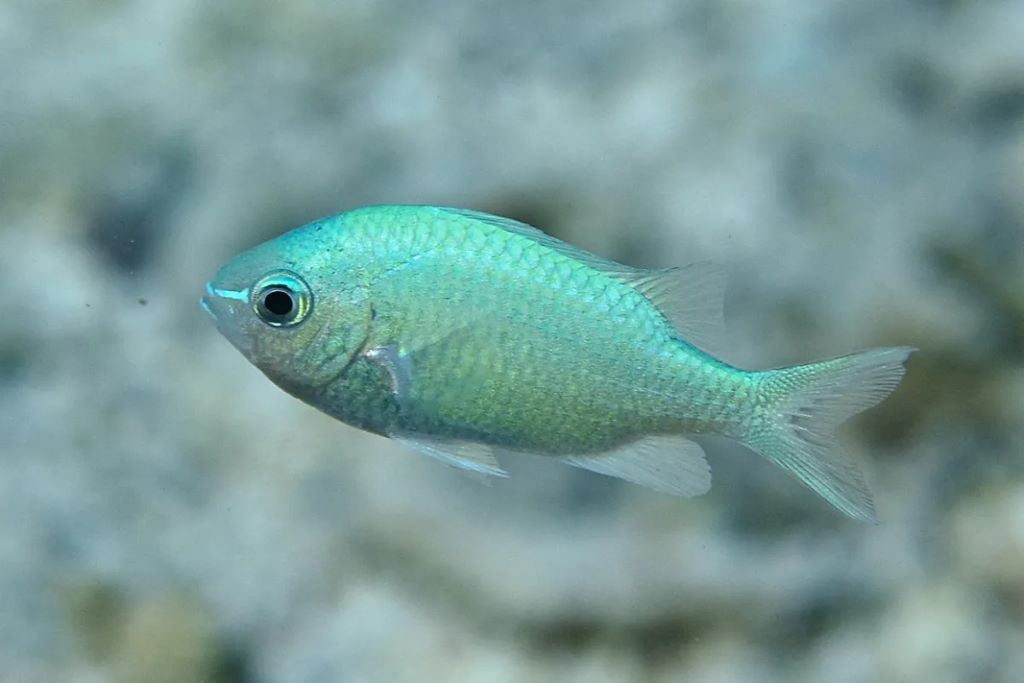
Review: The Blue Green Chromis is a peaceful and schooling fish that creates a mesmerizing spectacle in any reef tank. These shimmering beauties, with their iridescent blue-green bodies, swim in harmonious groups, adding a sense of tranquility and movement to the aquarium. They are hardy, easy to care for, and readily available.
Pros:
- Stunning schooling behavior: Watching them swim in synchronized groups is a captivating sight.
- Peaceful and social: They get along well with other peaceful fish and add a sense of community to the tank.
- Hardy and adaptable: They are relatively easy to care for and tolerate a range of water conditions.
Cons:
- Can be susceptible to ich: Maintaining good water quality and quarantine procedures are essential.
- May become skittish in small groups: It’s best to keep them in groups of five or more to promote a sense of security.
-
Banggai Cardinalfish (Pterapogon kauderni)
Review: The Banggai Cardinalfish is a unique and captivating fish with its striking black and white markings and elongated fins. These peaceful and slow-moving fish are mouthbrooders, meaning the males incubate the eggs in their mouths until they hatch. They are relatively hardy and add a touch of elegance to any reef tank.
Pros:
- Unique appearance: Their distinctive black and white pattern and elongated fins make them stand out in any aquarium.
- Peaceful temperament: They are non-aggressive and get along well with other peaceful species.
- Fascinating breeding behavior: Observing the males mouthbrooding the eggs is a captivating experience.
Cons:
- Can be sensitive to copper-based medications: Be cautious when treating the tank for diseases.
- May be susceptible to swim bladder issues: Providing a varied diet and maintaining good water quality can help prevent this.
-
Pajama Cardinalfish (Sphaeramia nematoptera)
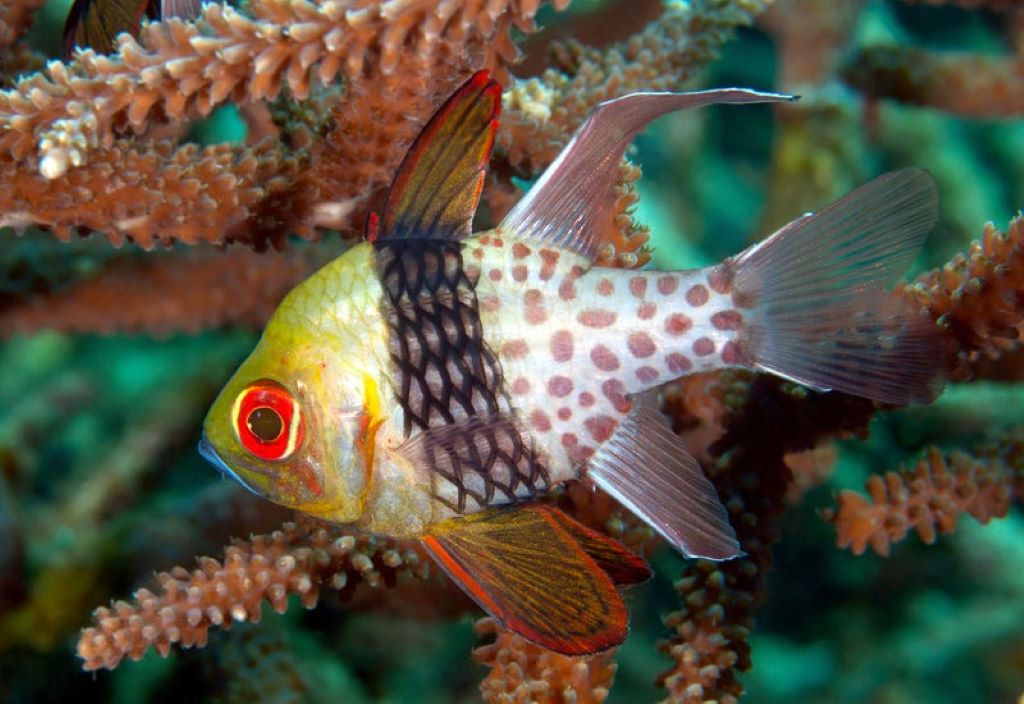
Review: The Pajama Cardinalfish is another captivating mouthbrooder with a distinctive appearance. Their bodies are adorned with a pattern resembling pajamas, hence their name. These nocturnal fish are relatively inactive during the day but become more active at night, adding a different dimension to the reef tank.
Pros:
- Unique coloration: Their “pajama” pattern makes them a visually interesting addition to the tank.
- Peaceful and shy: They are non-aggressive and prefer to stay hidden during the day.
- Interesting breeding behavior: Observing the males mouthbrooding the eggs is a fascinating sight.
Cons:
- Nocturnal: They are most active at night, so you may not see them much during the day.
- Can be sensitive to sudden changes in water parameters: Acclimate them slowly to the tank.
-
Purple Dottyback (Pseudochromis porphyreus)
Review: The Purple Dottyback is a small but vibrant fish that adds a splash of color to any reef tank. They are known for their striking purple coloration and their curious, active personalities. While they can be territorial, they are generally peaceful towards other fish that are not similar in size or appearance.
Pros:
- Beautiful coloration: Their vibrant purple hue makes them a visually appealing addition to the tank.
- Active and engaging: They are constantly exploring their environment, adding a dynamic element to the aquarium.
- Relatively hardy: They can tolerate a range of water conditions.
Cons:
- Can be territorial: They may become aggressive towards other dottybacks or similar-looking fish.
- May nip at corals or invertebrates: Provide ample space and hiding places to minimize this behavior.
Choosing the Right Fish for Your Reef Tank
While these ten fish are all excellent choices for beginners, it’s important to consider your specific tank setup and preferences when making your selection. Factors such as tank size, existing inhabitants, and your personal aesthetic preferences will all play a role in determining the best fish for your reef tank.
Remember to research each species thoroughly before adding them to your aquarium, ensuring that you can provide the appropriate environment and care they need to thrive. With careful planning and consideration, you can create a beautiful and harmonious reef tank that brings you years of enjoyment.
Frequently Asked Questions (FAQ)
-
What is the easiest saltwater fish to keep?
The Ocellaris Clownfish is often considered the easiest saltwater fish to keep due to its hardiness, adaptability, and readily available captive-bred specimens.
-
What is the most peaceful saltwater fish?
Many saltwater fish can be peaceful, but some of the most docile include the Royal Gramma Basslet, Firefish Goby, and Blue Green Chromis.
-
Can I mix different types of peaceful reef fish?
Yes, you can mix different types of peaceful reef fish, but it’s important to consider their individual needs and temperaments. Research each species thoroughly to ensure compatibility.
-
How many fish can I keep in my reef tank?
The number of fish you can keep depends on the size of your tank, the filtration system, and the individual needs of the species. A general rule of thumb is one inch of fish per gallon of water, but this can vary.
-
How do I introduce new fish to my reef tank?
It’s crucial to acclimate new fish slowly to your tank to avoid shock. Float the bag containing the fish in the tank for 15-20 minutes to equalize the temperature, then gradually add small amounts of tank water to the bag over an hour or so before releasing the fish.
-
What should I feed my peaceful reef fish?
Most peaceful reef fish are omnivores and will accept a variety of foods, including flakes, pellets, frozen foods (like mysis shrimp and brine shrimp), and even some algae-based foods.
-
How do I maintain good water quality in my reef tank?
Regular water changes, proper filtration, and avoiding overfeeding are crucial for maintaining good water quality. Test your water parameters regularly to ensure they are within the optimal range for your fish.
-
What are some signs of stress or illness in reef fish?
Signs of stress or illness in reef fish can include loss of appetite, lethargy, rapid breathing, discoloration, fin clamping, and erratic swimming. If you notice any of these signs, consult a veterinarian or experienced aquarist.
-
Can I keep corals with peaceful reef fish?
Yes, most peaceful reef fish are safe to keep with corals. However, some species, like angelfish, may occasionally nip at corals, so it’s important to choose your fish carefully and monitor their behavior.
-
Where can I learn more about reef keeping?
There are many resources available for learning more about reef keeping, including online forums, books, magazines, and local fish stores. Joining a local reef club can also be a great way to connect with other hobbyists and learn from their experience.




